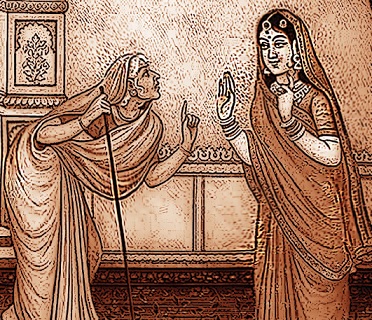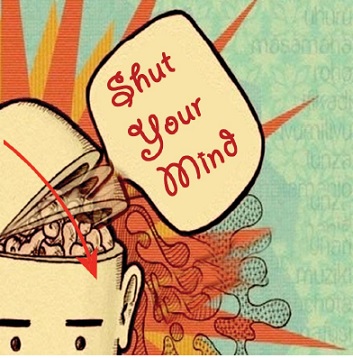
A Ramayana pastime conveys how we are prone to manipulation by those with vested interests and what we need to do for protecting ourselves
One of the most heartwrenching events in the entire Ramayana is the conspiracy that led to the exile of Rama. From the devotional perspective, this pastime sets the scene for, among other things, demonstrating the exalted spiritual emotion of love in separation. Simultaneously, from the ethical perspective, the pastime illustrates our human vulnerability to disinformation – it shows how even good people can get misled into doing terrible things.
As we live in a culture in which many vested interests promote their self-serving ends through systematic disinformation campaigns, a close look at this Ramayana pastime can offer us valuable insights for combating disinformation.

We live in a culture in which many vested interests promote their
self-serving ends through systematic disinformation campaigns
A Mission of Manipulation
This story unfolded in the city of Ayodhya, the capital of the kings of the solar dynasty. The reigning monarch Dasaratha had ruled virtuously for many years. On seeing his old age approaching, he felt inspired to transfer power to a worthy successor, his oldest son Rama. To formalize and finalize this decision, he called an extended assembly of courtiers and leading citizens from various classes. The assembly unanimously and delightedly seconded his decision, and resolved that the process for succession begin from the next morning itself.
From this jubilant public setting, the Ramayana’s spotlight shifts to a more private setting: the inner chambers of the palace of Kaikeyi, Dasaratha’s youngest wife. Due to her beauty, Kaikeyi had become the king’s favorite queen, thereby displacing his senior-most queen Kausalya. Despite the inevitable tensions created by such a power shift, the overall family atmosphere remained cordial. Neither Kausalya nor Kaikeyi bore any malice towards each other. Their respective sons, Rama and Bharata, as well as their two other siblings, Lakshmana and satrughna (sons of an intermediate queen Sumitra), lived in cheerful fraternal amity.
This familial harmony was destroyed in one night during which a self-interested person launched a mission of manipulation. That dark instigator was an elderly maidservant of Kaikeyi, Manthara. This hunch-backed spinster-schemester exploited the fissures created by the tensions between co-wives to trigger a catastrophic quake that inundated the whole of Ayodhya with a tsunami of agony.
The start of that fateful conversation between the maidservant and her queen gave little, if any, hint of its disastrous denouement. When Manthara informed Kaikeyi about Rama’s upcoming succession, Kaikeyi became joyful and gifted her maidservant a jewel necklace for bringing such good news. But Manthara hurled the necklace on the ground and called Kaikeyi a naive fool for not seeing what was happening. The audacity of the wicked maid stemmed from her frenzy for selfpreservation. She wanted to maintain at all costs her privileged position in the royal palace as the favorite maidservant of the king’s favorite queen. If Rama became the king, she feared that his mother would become the foremost dowager and Kaikeyi would be relegated to the position of just another member in the royal family. This would downgrade Manthara to the level of just another maidservant. Due to her hunchback, Manthara had sometimes been the butt of friendly jokes. Though such teasing hadn’t been malicious, she had resented it bitterly. Such banter had stopped with her ascension to a prominent position in the royal staff. Dreading a return to a position of insignificance and scorn, she decided to use her wiles on Kaikeyi and somehow stop the transfer of power.
Manthara told Kaikeyi that the haste with which the succession ceremony was being executed, especially during the absence of Bharata, pointed to a conspiracy to deprive the absent prince of power. Actually, Bharata’s absence was simply a happenstance – he was out-of-station when the king felt an inner call to retire and promptly acted on it. Moreover, Bharata being the youngest son had no claim to the throne, which was meant to go by primogeniture to the eldest son Rama.
Such facts notwithstanding, Manthara exploited the happenstance of Bharata’s absence to sow a seed of suspicion in Kaikeyi’s heart. And then she watered that seed well into the night with a dystopian tale spun from her evil imagination. Exploiting the feminine jealousy typical among cowives, she painted a nightmarish future in which a vindictive Kausalya would have Kaikeyi reduced to a veritable serving maid and a despotic Rama would have Bharata incarcerated, if not executed. Thus, starting with what was not even a mole, Manthara made a massive mountain that crushed Kaikeyi’s affection for all her family members except Bharata. By the end of Manthara’s diatribe, Kaikeyi became ready to do anything for stopping what she saw as a conspiracy against her and her son. When her maid suggested that she use an old promise by the king that he would grant her two wishes, she readily agreed to ask that firstly Bharata be designated as the royal heir and secondly Rama be exiled to the forest for fourteen years. Anticipating that the king would vehemently oppose his beloved son’s banishment, Manthara told Kaikeyi to not go soft on that demand – only when Rama was outside the kingdom and indeed outside any position of political power would Bharata be able to secure his hold on the throne.
Hard Heart Breaks Hearts
What followed was a collision between Kaikeyi’s heart and Dasaratha’s heart. While the king’s heart was soft and exuberant at the prospect of his dear son Rama’s coronation, his queen’s heart had become harder than stone due to dwelling on the perceived conspiracy against her son Bharata. When their hearts collided, the impact left the king heartbroken.
After finishing the arrangements for the ceremony next day, the joyful king came to his favorite queen’s palace late at night. When she reminded him of his past promise, he unsuspectingly reiterated his commitment to honor it. But when she voiced her two wishes, he was petrified by shock and collapsed in a swoon. On returning to consciousness and realizing that the nightmare was real, he strove feverishly to deter his wife from her ruthless resolve. Finally, he broke down into piteous tears and fell begging at her feet – both actions utterly uncharacteristic of a monarch. Yet Kaikeyi remained unmoved by her husband’s desperate pleas. Worse still, she misinterpreted those pleas as evidence of his partiality and complicity.
Being bound by his word of honor, the king was forced to grant her wishes. But being horrified to see that his loving wife had become an unfeeling ogress, he disowned her. In a voice choked with agony and fury, he declared that with the granting of her wishes, his obligation to her was over, as was his relationship with her.
Despite hearing such a dreadful declaration, Kaikeyi still remained unrelenting. Her heart had become so cold and hard that it had no room left for anything except her scheme – no room for any conjugal affection for her husband; no room for any maternal affection for her step-son Rama who was disarmingly gracious in accepting the grievous diktat against him; no room for feminine concern for her daughter-in-law Sita who gave up her royal garments to don rough tree-bark and join her husband in his exile; no room for respect for the venerable royal priest Vasistha who implored her to desist from such a nefarious plan; and no room for fear of public censure as the outraged courtiers and citizens condemned her. After Rama departed for the forest, the whole of Ayodhya sank into an ocean of lamentation. But not one drop of that ocean touched Kaikeyi’s heart.
The aggrieved Dasaratha found separation from his beloved Rama unbearable. Even more agonizing was the thought that he himself had sentenced his son to exile – a sentence reserved for the worst of criminals, a sentence just one level below execution, a sentence meted out unjustly to one who had done no wrong. Crushed by anguish, Dasaratha’s broken heart broke down totally and he breathed his last. Kaikeyi still remained unfazed even after the death of her husband, who had for so long cherished her as his favorite queen.
The Imaginary Bharata versus the Real Bharata
The transmogrification of Kaikeyi from wise, kind and gentle to foolish, cruel and harsh is unbelievable. Given that she was not innately evil, how did she justify to herself her horrendous actions? By masking them in the garb of vigilant maternal concern. She imagined that she was doing all this for her son Bharata, who being absent couldn’t protect his interests and had no one but her to protect them. She believed her maternal rationalization so completely that nothing else mattered to her – no one’s words, emotions or actions could dent her resolve. Yet her justification couldn’t but crumble to powder when debunked by the very person it claimed to defend: Bharata.
Kaikeyi’s son had anxiously hastened to Ayodhya, being summoned by Vasistha, who was officiating as the provisional head of state during the emergency created by the king’s demise and the princes’ absence. On arriving in Ayodhya, he saw that the bustling and cheery city looked desolate and dreary, like a ghost town. Feeling deep misgivings, he rushed to his mother’s chambers, expecting to meet both his parents there. On seeing his mother, he offered her his respects and enquired about his father’s wellbeing. Kaikeyi recounted her own version of events, stressing how she had done so much to protect Bharata’s right to the kingdom.
Bharata was too sharp to fall for such spin doctoring. Hearing about his father’s demise and his brother’s exile left him devastated. Hearing that these calamities had been instigated by his own mother left him horrified. Hearing her claiming that she had done all this for his sake left him sickened. He found his mother’s words so revolting that he felt sorely tempted to violate the kñatriya code that one should never raise one’s hand against a woman. Somehow checking himself, he poured his fury out in words. Castigating his unrepentant mother, he deemed her an evil witch born for the destruction of their dynasty.

To counter the mind’s insidious insinuations, we need to
meticulously avoid the mistakes that Kaikeyi made
Kaikeyi heard her son’s denunciation with disbelief and dismay. With her imagination, she had fashioned a Bharata who lauded her actions. When the real Bharata categorically condemned those very actions, she realized to her horror that the Bharata of her imagination was nothing more than her imagination. As that imaginary Bharata died a quick death, so did her rationalization. And the monstrosity of what she had done hit her with a force of a thousand thunderbolts. She repented fervently, begging for Bharata’s forgiveness and even going with him to the forest to second his request that Rama return and reclaim the throne. But it was too late – the juggernaut had already gained a fearsome momentum and nothing, not even its first pusher, could stop it.
How did Kaikeyi conflate her noble son with the conniving figment of her imagination? By a double blunder: she believed uncritically whatever Manthara told her, and she didn’t seek any second opinion. She let herself be so persuaded by just one person’s view that she rejected everyone else’s advice.
Modern Mantharas
Today many Mantharas in the form of agenda-driven agencies run their own disinformation campaigns. Perhaps the most ghastly modern example of devastation through disinformation is the Holocaust. By whipping up frenzy against various supposed enemies of Germany, Hitler poisoned an entire nation against its minority communities and slaughtered over ten million people.
Similarly, many multinational companies use disinformation to boost up their profits. In Sugar Salt Fat: How the Food Giants Hooked Us, Pulitzer prize-winning author Michael Moss explains how a massive disinformation campaign has caused the modern addiction to unhealthy eating.
Such disinformation afflicts even the realms of religion. In Fighting to the End: The Pakistan Army’s Way of War published by the Oxford University Press, Professor C. Christine Fair, a security studies expert at Georgetown University in America, documents in the Pakistani military structure a pervasive anti-India disinformation campaign that often uses explicit anti-Hindu imagery. In some Pakistani schools, childhood innocence is slaughtered when arithmetic lessons are misappropriated to indoctrinate students with hate messages: “If out of seven Hindu kafirs (infidels), four are shot dead, how many remain?”Such disinformation is especially sinister because herein hatred is worse than propagated – it is presumed as a given fact of life. Those thus disinformed feel no hesitation in perpetrating any atrocity because they have unwittingly bought into a self-congratulatory worldview that rationalizes any assault on “the evil other.” The point of this example is not to stigmatize any particular religion or country – objective study shows that all religions and all countries have tainted historical records. The point is that disinformation threatens every aspect of society, and nominal religious affiliation is no insurance against it.
Today’s hi-tech world gives access to multiple channels of information – does such access decrease humanity’s vulnerability to misinformation? Not necessarily. Disinformed people can use such channels not to disabuse themselves, but to perpetuate and propagate their mistaken beliefs. This is evident in the aggressive use of social media by extremist organizations such as ISIS.
Spiritual Empowerment
To protect ourselves from disinformation, we need to strengthen our intellectual and ethical muscles. With stronger intellects, we can penetrate to the actual beyond the apparent, thereby discerning the disingenuity in disinformation. With better ethical muscles, we can resist the promises of quick pleasure that disinformationists dangle to make us lower our guard.
The process of bhakti-yoga helps us strengthen both these muscles. Devotional study of scripture sharpens our discerning power and hones our intellectual muscles. Devotional remembrance of Kåñna provides a higher inner fulfillment that empowers us to say no to lower temptations.
Unfortunately, disinformation is so pervasive that it can distort our perception of bhakti-yoga too. With a barrage of half-truths and untruths about spirituality and spiritual organizations, disinformation can assault our sacred faith. We can best protect our faith by entirely avoiding such anti-devotional propagandists. But if we somehow hear from them, we shouldn’t let their opinions alone determine our spiritual decisions. By seeking clarification from trustworthy spiritual mentors, we can get a balanced understanding that preserves our faith in bhakti’s potency.
Disinformation threatens us not just externally but also internally. If we compare Ayodhya with our heart, then Manthara is like the mind. The mind comes up with the deadly duo of doubt and desire: doubt paralyzes our devotion and desire aggravates our worldly infatuation. Being misled by the mind, we become like Kaikeyi and exile the Lord from our heart.
To counter the mind’s insidious insinuations, we need to meticulously avoid the two mistakes that Kaikeyi made. Firstly, we need to avoid hearing the mind. Unfortunately, the mind is always with us and it always has the opportunity to spin its self-serving yarn – so, we need to be constantly vigilant. Secondly, if the mind’s persuasion starts swaying us from our moral and spiritual principles, we need to counter it with the enlightening voices of guru, sadhu and sastra. We can take both these precautions by conscientiously engaging ourselves in devotional service. By such absorbing spiritual engagement, we will preempt the mind’s misleading stratagems and will instead be led by timeless wisdom towards our all-round wellbeing.
Caitanya Carana Dasa is the associate-editor of Back to Godhead (US and Indian editions). To read his daily Bhagavad-gita reflections, please subscribe to Gitadaily on his website, thespiritualscientist.com.
